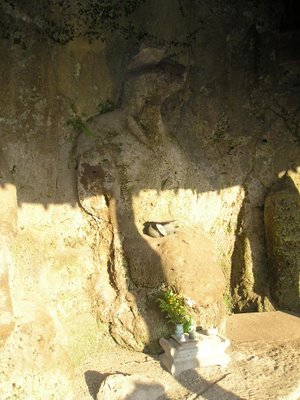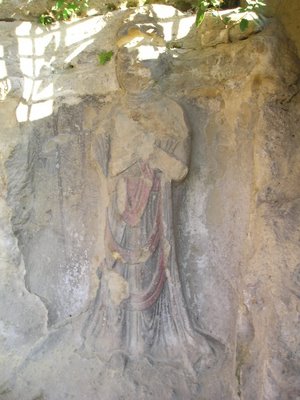Somehow, I knew that I would someday visit Japan. I told this many years ago to a Japanese war veteran who used to make annual pilgrimages to Almaguer. He came every year, bringing with him different groups who have lost a family somewhere in Almaguer during the war. They would usually burn incense, spread offerings of sake and rice, and pray at the bridge that now divides Almaguer into North and South. Perhaps it was a battle site, like Lakay Sammy’s bangcag near the dacquel nga carayan where the Samahang Dilim was always hired to dig for remains of Japanese soldiers buried there. Lakay Sammy is father to Roy who --- with Abet, Junie, Ninoy, Tok, Piso, and Ukong --- ruled the dark nights of Almaguer. They were paid P150 per day that was big money at that time, and more so if they find gold teeth fillings and caps. The recovered remains were then cremated in a big bonfire and the ashes brought back to Japan for proper interment.
The Samahang Dilim dug even without the annual Japanese visitors --- for the gold teeth fillings and caps. On one such day, Abet tunneled a santol tree and found a fairly intact skeletal remain. But there was no gold. Instead, they found some rusty Japanese coins (Abet though they were uniform buttons), a fork, and what could have been film negatives. This and the others that they recovered were eventually turned over to the annual visitors. There was also that unexploded bomb near the latrine of Amang Lakay that Kuyang Uben finally disposed (before his soldiering days) by throwing it at the fish pond of Lakay Amplaying.
Part of our training course was a visit to nearby Asuke in Toyota City an hour from Nagoya. The place is famous for its Korankei Gorge that is said to be the second best place in Japan for the autumn maple leaves viewing. In 1634, the Buddhist priest Sanei from the Kojakuji Temple planted the first maple trees that have made Asuke famous centuries later. The maple leaves should have been bright red when we came but we were told that because of global warming, this had been delayed by 2 weeks since 2 years ago. Nestled on the Korankei Gorge is the Sanshu Asuke Yashiki museum where we were shown a traditional Japanese home and the production of local handicrafts.






We stayed in Oita for 4 days and from there made guerilla visits to the famous Yufuin area and in Oyama where I had my best Japanese lunch ever, then Fukuoka where we took the plane back to Nagoya.



PHOTOS (top to bottom)
1) Asuke’s Korankei Gorge.
2) The famous momiji or maple leaves.
3) A Buddhist altar inside a traditional Japanese home at the Sanshu Asuke Yashiki Museum.
4) The main image of the Motomachi Stone Buddhas and 5) an image eroded by time.
6-7) The Iwayaji Stone Budhhas.
8) Yufuin’s Mt. Fukuman.
9) The Tenso Shrine is marked by a torii at Yufuin’s Lake Kinrinko.
10) An ancient plum tree in Oyama.
The Samahang Dilim dug even without the annual Japanese visitors --- for the gold teeth fillings and caps. On one such day, Abet tunneled a santol tree and found a fairly intact skeletal remain. But there was no gold. Instead, they found some rusty Japanese coins (Abet though they were uniform buttons), a fork, and what could have been film negatives. This and the others that they recovered were eventually turned over to the annual visitors. There was also that unexploded bomb near the latrine of Amang Lakay that Kuyang Uben finally disposed (before his soldiering days) by throwing it at the fish pond of Lakay Amplaying.
Part of our training course was a visit to nearby Asuke in Toyota City an hour from Nagoya. The place is famous for its Korankei Gorge that is said to be the second best place in Japan for the autumn maple leaves viewing. In 1634, the Buddhist priest Sanei from the Kojakuji Temple planted the first maple trees that have made Asuke famous centuries later. The maple leaves should have been bright red when we came but we were told that because of global warming, this had been delayed by 2 weeks since 2 years ago. Nestled on the Korankei Gorge is the Sanshu Asuke Yashiki museum where we were shown a traditional Japanese home and the production of local handicrafts.



A day later, we were on our way to the southern resort city of Oita. We covered the 700 kilometer distance from Nagoya in 3 hours through an exhilarating ride in Japan’s fabled shinkansen or bullet train. Oita has been the prefecture capital for 1,300 years since the era of the Bungo Kokufu. It is famous for its nearby hot spring spas and home to the Motomachi Stone Buddhas of the Heian Period (794-1192) that were carved on the side of the Uenogaoka Hill. I tried going there by bus but it’s quite complicated for a non-Japanese like me so I walked and got lost. A taxi finally took me to the shrine that had been declared as a national historic monument. Some 200 meters away is the prefectural historic monument of the Iwayaji Stone Buddhas. I touched those ancient holy stones and said my prayers. It was a strange ghostly feeling.





We stayed in Oita for 4 days and from there made guerilla visits to the famous Yufuin area and in Oyama where I had my best Japanese lunch ever, then Fukuoka where we took the plane back to Nagoya.



PHOTOS (top to bottom)
1) Asuke’s Korankei Gorge.
2) The famous momiji or maple leaves.
3) A Buddhist altar inside a traditional Japanese home at the Sanshu Asuke Yashiki Museum.
4) The main image of the Motomachi Stone Buddhas and 5) an image eroded by time.
6-7) The Iwayaji Stone Budhhas.
8) Yufuin’s Mt. Fukuman.
9) The Tenso Shrine is marked by a torii at Yufuin’s Lake Kinrinko.
10) An ancient plum tree in Oyama.
No comments:
Post a Comment